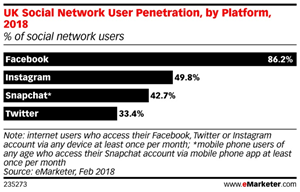Facebook is losing friends among teens and young adults, according to eMarketer’s report on UK digital users, which is set to be released later this month.
In 2018, 2.2 million individuals ages 12 to 17, or 71% of social network users in this age bracket, will be using Facebook regularly—this represents a downgrade of eight percentage points over eMarketer’s earlier forecast.
eMarketer also reduced its estimates for Facebook usage among 18- to 24-year-olds by more than five percentage points. In 2018, 83% of social network users aged 18-24 will be Facebook users, this share will drop to 81.5% by 2021.
Overall, the number of total Facebook users in the UK will reach 32.6 million in 2018. While Facebook still stands well ahead of Instagram, Snapchat and Twitter in terms of overall user numbers, the drop among younger age groups suggests that its rivals are taking some of the share.
Leading the charge for younger audiences is Snapchat. In 2018, close to 43% of UK social network users will log onto Snapchat—more than double its penetration rate from three years ago. Snapchat’s popularity with teens and young adults has grown significantly since the platform first launched in 2011.
Snapchat has also introduced a range of interactive features that have appealed to teen audiences, in turn driving up the user number. Conversely, that has arguably turned off older audiences who favor Facebook’s less complicated social network experience.
“Facebook’ has a ‘teen’ problem,” said Bill Fisher, eMarketer’s UK senior analyst. “This latest forecast indicates that it’s more than a theory. And whereas it’s been able to rely on platform shifters being hoovered up by Instagram, there are now some early signs that younger social networkers are being swayed by Snapchat. The challenge and opportunity for Snap is how to appeal beyond that core youth demographic.”
Methodology
eMarketer’s forecasts and estimates are based on an analysis of quantitative and qualitative data from research firms, government agencies, media firms and public companies, plus interviews with top executives at publishers, ad buyers and agencies. Data is weighted based on methodology and soundness. Each eMarketer forecast fits within the larger matrix of all its forecasts, with the same assumptions and general framework used to project figures in a wide variety of areas. Regular re-evaluation of available data means the forecasts reflect the latest business developments, technology trends and economic changes.

